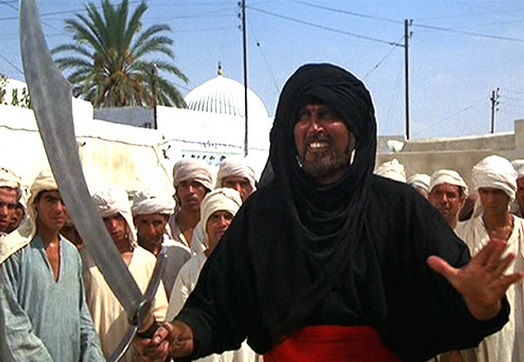  |
 |
 |
 |
|
MahdiWatch.org
|
 |
|
Home | About Me | Links to My Articles | Info on My Books | Contact Me
|
 |
|
Welcome to MahdiWatch.org! NEWSFLASH! COMMENTS LINK
BELOW EACH POST IS ENABLED! FEEL FREE TO BURY ME, PRAISE ME--OR JUST ISSUE A PERSONAL FATWA!
al-Mahdi is "the rightly-guided one" who, according to Islamic Hadiths (traditions),
will come before the end of time to make the entire world Muslim. Over the last 1400 years numerous claimants to the
mantle of the Mahdi have arisen in both Shi`i and Sunni circles. Modern belief in the coming of the Mahdi has
manifested most famously in the 1979 al-`Utaybi uprising of Sa`udi Arabia, and more recently in the ongoing
Mahdist movements (some violent) in Iraq, as well as in the frequently-expressed public prayers of former Iranian
President Ahmadinezhad bidding the Mahdi to return and, in the larger Sunni Islamic world, by claims that Usamah bin Ladin
might be the (occulted) Mahdi. Now in 2014 Mahdism is active in Syria, as the jihadist opposition group Jabhat al-Nusra
claims to be fighting to prepare the way for his coming; and in the new "Islamic State/caliphate" spanning
Syrian and Iraqi territory, as its leadership promotes the upcoming apocalyptic battle with the West at Dabiq, Syria. This site will track such Mahdi-related movements, aspirations, propaganda and beliefs in both Sunni and Shi`i
milieus, as well as other Muslim eschatological yearnings.
For a primer
on Mahdism, see my 2005 article, "What's Worse than Violent Jihadists?," at the History News Network: http://hnn.us/articles/13146.html; for more in-depth info, see the links here to my other writings, including my book on Mahdism.
|
|
|
|
Wednesday, January 23, 2013
Counter-Terrorism: Lies, Damn Lies and Memes
11:42 pm est
Wednesday, January 16, 2013
Brennan and CIA: All Eyes and No Sight When It Comes to Islam
Since President Obama nominated his current chief counter-terrorism advisor, John Brennan, to be the next CIA director criticism
has focused on Brennan's alleged Bush administration involvment in "enhanced interrogation techniques" and rendition,
as well as his shaping of the current administration's extensive terrorist-killing drone program. But these are tactical, albeit very important issues-and much more problematic, strategically, is Brennan's worldview
toward Islam which, in effect, is the Obama administration's position writ large: generally, "describing
our enemy in religious terms" is wrong and counterproductive; specifically, "nor do we describe our
enemy as ‘jihadists' or ‘Islamists' because jihad is a holy struggle, a legitimate tenet of Islam, meaning to purify oneself or one's community, and there is nothing holy or legitimate
or Islamic [emphasis added] about murdering innocent men, women and children." 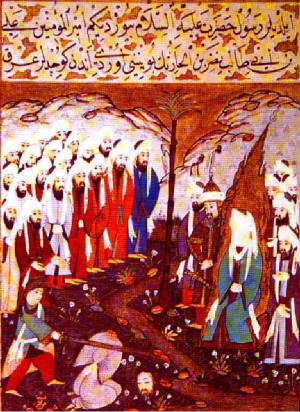 Ali beheading Nasir b. al-Harith at Muhammad's order. According to John Brennan, this
was neither holy, nor Islamic, nor legitimate. Ali beheading Nasir b. al-Harith at Muhammad's order. According to John Brennan, this
was neither holy, nor Islamic, nor legitimate.Brennan's view has been encapsulated for
some time in the CIA's "Political Islam Strategic Analysis Program" [PISAP] which is described on the agency's website thusly: PISAP "was established in 2004 in recognition
that forces that have have not traditionally been studied, in a comprehensive manner, by the Intelligence Community needed
to be examined as they affect the national security interests of the United States. The effort does not
focus on Islam as a religion or on the worldwide Muslim community; rather, it examines those organizations that use religion
for political purposes and use religious ideology to attempt to change the existing political, social, or economic order...."
[emphasis added]. So according to the next CIA director, and the analytical arm of his agency, Islam per
se is off-limits as a subject of study, yet the Islamic concept and 1,400-year-old politico-military policy of jihad
is Islamic-except when a noted non-Muslim like John Brennan says it's not? Brennan's
misapprehensions, or misrepresentations, of jihad have been meticulously documented and critiqued already, most notably
by the very able and knowledeable Patrick Poole-so there is no need for me to revisit that ground except to note the following: if violent jihad has no legitimacy
in Islam, then why are 31 of 51 FTOs (Foreign Terrorist Organizations) on the State Department list Islamic? And why do such groups invoke, as both justification and motivation, the jihad-waging examples of not just
"prophet" Muhammad but (if they're Sunni) the first four caliphs, the Abbasid caliphs, Salah al-Din and the
Ottoman sultans or (if they're Twelver Shi`i) Ali, Husayn, the Safavid shahs and the "martyrs" of the modern Islamic
Republic of Iran? John Brennan, according to his bio, has a M.A. with a specialization in Midde Eastern studies from the University of Texas-Austin; speaks Arabic; and was the
station chief in Saudi Arabia in the 1990s. Unless UT's academic program is far less rigorous that those of us in the
field have been led to believe, Brennan would have had to study some Islamic history, and thus would know full well the quintessentially
Islamic nature of jihad, as well as its supreme importance in Muslim religious, military and political history. (For
Allah's sake, the Ottoman Empire officially issued a fatwa [Turkish "fetva"] of jihad against the World War I Allies in 1914!) Assuming that this is the case-then why
does he pontificate so ahistorically and inaccurately? Some think that this is part of a clever strategy by the Obama
administration both to 1) drive a wedge between jihadists and the rest of the world's Muslims, and 2) force (or at least entreat)
Muslims, especially within the US, to re-think their own religion's doctrines, starting with the thorny jihad one-and, ultimately,
to disown it. So our only options would seem to be that this administration's counter-terrorism policy-which is, de facto
if not de jure an anti-ISLAMIC terrorist agenda, since we don't have legions of Predators spanning
the globe and launching Hellfire missiles at congeries of "right-wing extremists," soccer hooligans or Tea Partiers
(at least not yet)-either is woefully ignorant of Islamic history and doctrines, OR that it is, on the contrary, well-informed
about them but intentionally duplicitious for strategic reasons. 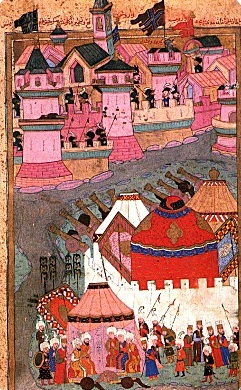
Also "not jihad," according to Brennan; those are Ottoman "pipes of
peace" aimed at Vienna!
Since the first alternative is simply beyond the pale of logic
(as well as being too horrible to contemplate), let us accept arguendo the second-which is hugely problematic in
its own right. To gauge this, let us see how the perspective of John Brennan and the CIA's Directorate of Analysis
would work (or, more accurately, not work) when applied to Mahdism, Shi`ism and the Islamic Republic of Iran [IRI].
Several analyses of belief in the Mahdi and its effect on the policies of the IRI have been done-most notably my "A Western View on Iran's WMD Goal: Nuclearizing the Eschaton or Pre-Stocking the Mahdi's Arsenal," and Mohebat Ahdiyyih's "Ahmadinejad and the Mahdi," as well as Charles Cameron's take on the importance of Mahdism in general as a topic of analysis. Rather less academic, but more recent, is Hosam Matar's "The Mahdi and Iran's Foreign Policy," which ran on the English site of the Lebanese daily al-Akhbar on January 11, 2013. Mr. Matar makes
a number of valuable observations about Mahdism among the ruling clique in Tehran (and Qom), most notably: that the ruling
ayatollahs and politicians view their state as needing to be created in the (imagined) image of the the future, post-occultation
Mahdist kingdom (as I wrote about five years ago)-whether passively (the traditional view) by waiting on Allah to make it so, or actively (the Khomeinist position), in which
"believers must strengthen their faith individually and socially, promote Islam, and build the necessary power to prepare
for his return." (Quite likely up to, and including, nuclear weapons-as I expound upon in my aforementioned article.)
Matar also observes that this view is not limited merely to the upper echelons of power in Tehran: "since Iran is the
world's leading Shia [sic] power, many Iranians expect that it will play a major role in preparing for the Mahdi and in his
subsequent activity. This belief renders Iranian Mahdism enormously significant in global politics."
But if anything Matar understates the issue, by positing Mahdism as purely an Iranian and Twelver Shi`i phenemenon-which
it most decidely is not. Of the world's 200 million or so Shi`is, Twelvers do comprise the majority-but in addition
to Iran they are a majority in Azerbaijan, Iraq and (almost certainly) Lebanon, as well as constituting significant minorities
in Afghanistan and Pakistan. Furthermore, there are several other major branches of Shi`ism besides Twelvers: Isma'ilis,
or Seveners; Zaydis, or Fivers; Alawis; and Druze. Although none of these sects has the same messianic expectation as
the Twelvers (and the numbers pertain to how many "Imams," or divinely-guided descendants of Muhammad through Ali
and Fatima, are legitimate), they are nonetheless in varying degrees open to eschatological suasion in general and Iranian
influence in particular-the Zaydis of Yemen and the Alawis of Syria foremost among them.
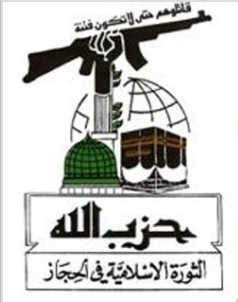
Logo of the former Hizb Allah al-Hijaz, "Party of God in the Hijaz" (Western Arabia)--the
Shi`i and Iranian-supported anti-Saudi-regime terrorist group. Pay no attention to those renderings of the Ka`bah and
al-Aqsa Mosque (in Jersualem--or "al-Quds," as Brennan says)--they are NOT religious! Likewise, that rifle
is NOT violent! (Similar deconstruction of Islamic groups' logos could be multiplied massively.)
Furthermore-and
as per the very raison d'etre of this site-Mahdism is also a very real concern in the majority Sunni branch of Islam,
as evidenced by the legion of Sunni Mahdist claimants and movements that has surfaced over a millenium or more of Islamic
history, and by the continuing outbreak of such efforts today. Considering, then, the strength of Mahdism in both Shi`i
and Sunni Islam, the major modern manifestations would include, at a minimum: ●
Mahdism is the operative ideology in the world's foremost state sponsor of terrorism: Iran ●
At least half-a-dozen self-styled mahdis have proclaimed themselves publicly in staunchly Sunni Saudi Arabia in the last several
years (and the Kingdom was the locale for the last overtly militant Mahdism in the Sunni world: 1979's Mahdist occupation of the Great Mosque in Mecca) ● Iraq is home to at least four organizations claiming to be
preparing the way for the Mahdi, either peacefully (Ansar al-Mahdi; Jaysh al-Husayn) or violently (Jaysh al-Mahdi; Jund al-Sama') ●
Another violent eschatological group, Ansar al-Mahdi, is bedeviling Morocco ●
Muslim Brotherhood-dominated Egypt, in the last year, has seen a chap proclaiming himself Mahdi and running for President
as well as the presence of da`is ("missionaries") from Iraq's Ansar al-Mahdi in Cairo ●
The Turkish Creationist and promoter of (peaceful) Mahdism, Adnan Oktar, continues a torrent of publications and lectures;
many of his followers believe that he himself is the Mahdi. ●
The Zaydi "rebellion" in Yemen has as one of its aims the re-establishment of a Shi`i polity in the northern part
of the country, as well as the resurrection of the Fiver Shi`i Imamate-at least as a religious institution. ●
The Nurbakhshi neo-Sufi and Mahdist sect of extreme northern Pakistan "has been targeted for conversion by the Twelver
Shi`is [of Iran] in their quest for demographic and regional expansion" (Shahzad Bashir, Messianic Hopes and Mystical
Visions: The Nurbakhshiya between Medieval and Modern Islam, University of South Carolina Press, 2003; p. 286)
● Rural Iran itself is also home to "a phenemenon referred to popularly as the ‘thirteenth imam'" which
"although anathema in official and mainstream Twelver Shi`ism...has nevertheless persisted...." and "could
gather a nucleus of antiestablishment supporters" (Farhad Kazemi, "Ethnicity and the Iranian Peasantry," in
Milton J. Esman and Itamar Rabinovich, eds., Ethnicity, Pluralism and the State in the Middle East, Cornell University
Press, 1988, pp. 201ff).
This wide range of Mahdist organizations, both Shi`i and Sunni and stretching from
the Maghrib to South Asia, is utterly incomprehensible if approached from the myopic vantage
point of John Brennan or the CIA's PISAP program-since few of these movements is overtly political, yet many of them espouse
violent jihad. In fact, many Mahdist movement in Muslim history were apolitical right up to the point at which they
flipped a switch and transmogrified into violent political revolutions--a point which cannot be scientifically determined
but which can be at least estimated if one studies ISLAM's doctrines and history rather than ignore them.
And just how is "us[ing] religious ideology to attempt to change the existing political, social or economic order"
to be differentiated from the intrinsic and general Islamic imperative to "command right and forbid wrong" as well as the more specifically Mahdist focus on socioeconomic justice-unless one studies the banned topic of Islam as a religion? DCI-designate Brennan's dismissal of jihad as both "Islamic"
and "legitimate," whether one deems it fatuous or fiendishly Machiavellian, blinds him to this inconvenient but
supremely important historical truth: that since jihad has been both "Islamic" and "legitimate" for most
Muslims over the the last 1,434 years, perhaps it would behoove us to stop denying that and find allies in the ummah
for whom it is also "holy"-or, conversely, ones for who jihad has been ruled out as illegitimate and who can
make the case more convincingly than a US government official who is (presumably) Catholic. (Brennan's telling Muslims
what is and is not "legitimately Islamic" makes about as much sense-and carries as much weight-as our Episcopalian Attorney General Eric Holder doing so.)
Islamic groups who consider jihad "holy war" and are willing to engage in it against Salafis,
or "fundamentalist" Sunni Muslims (which includes al-Qa`idah in all its manifestations), would include several Sufi
orders: the pan-Sufi Ahl al-Sunnah wa-al-Jama`ah which has been battling al-Shabab in Somalia for several years;
the Sanusis in Libya; the Qadiris in Mali; any number of tariqat in Egypt. Islamic sects that, conversely,
have indeed ruled out violent jihad as a doctrine are in the minority (and generally deemed heterodox by mainstream Muslims)
but can, at the very least, offer alternative views; these would include most notably the Ahmadis and Isma'ili Shi`is,
as well as some other Sufi orders.
But a US intelligence community that looks only at non-religious aspects
of the Islamic world (note how oxymoronically that reads!), striving to find only secularist allies therein, renders itself--no
matter how many satellites, reconnaissance drones, data-sifting software programs and even HUMINT assets it employs--"all
eyes and no sight" (Troilus and Cressida, Act I, Scene 2). Brennan's insistence on ignoring the realities of Islamic doctrine and history, even if feigned, keeps us blind to all else that moves to our benefit in the world of Islam.
Saturday, January 5, 2013
A Mahdi by Any Other Name--Would Still Kill the Jews?
Now that the Mayan Non-Apocalypse has come and gone with nary a whimper, it's time to return attention to the strain of
apocalyptic thought that potentially could produce a big bang: the Islamic kind. Predictions, and warnings,
of the Mahdi's appearance continue to proliferate in both major sectarian branches of Islam, as well as in several major areas
of the Islamic center. In the Twelver Shi`a world: I.
The Karbala (Iraq)-based Shafaqna Shi`a News Association recently has been running a three-part series on "Signs of the
Reappearance of Imam Mahdi." The first installment, as well as the second, discussed the astronomical signs that allegedly will precede and/or accompany the Mahdi's return. The third focused on the Mahdist precursor figures, the Sufyani and the Yamani-the former a "type" of the Dajjal, or Islamic
antiChrist; the latter an End Time good guy (for Muslims) whom Shafaqna earlier (in 2012) had already seen portents of in the ongoing Hawthi Zaydi (Fiver Shi`i) rebellion against the Sunni regime in Sana`a, Yemen. II. For the better part of a decade,
there has been an active Mahdist movement in Iraq whose leader, Ahmad al-Hasan "al-Yamani," claims to be the very
aforementioned eschatological figure from southwestern Arabia. (I wrote a long blogpost on this group back in 2008.) They are called Ansar al-Mahdi ["Helpers of the Mahdi;" henceforth AAM] and run a
website as well as publish, every few months, a rather lengthy broadsheet called "The Mahdi Times." The latest edition,
from November/December 2012, is largely concerned with the group's establishment of a branch in Egypt-the Sunni Arab world's most-populous country-and
the (alleged) government opposition thereto. A few notable points: the Egyptian opposition to al-Hasan's messianic da`wah
is referred to as "Yazidi" (a pejorative term in Iraqi and Iranian Shi`ism for the heteoodox beliefs of some Kurds) and/or "Salafi" (Sunni fundamentalist); only a few of AAM's members are said to know Arabic, thus indicating most
are not from Egypt or Iraq; there is at least one American, one Joseph McGowen, among the AAM-perhaps helping explain why,
when government security forces accosted AAM over alleged visa irregularities, the American embassy is said to have helped;
at least one Egyptian TV station would regularly attack AAM (before it went off the air); and al-Hasan claims that his father
is the occulted 12th Imam, Muhammad b. al-Hasan-which would mean he was sired by a five year-old boy, since the last Imam
was born in 868 and assumed ghaybah ("occultation") in 873 (unless he somehow reached to puberty and beyond
in that mystical state).
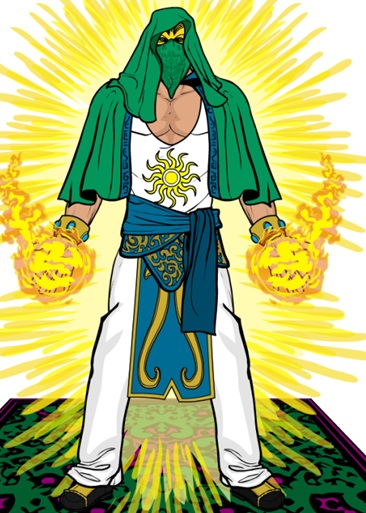
The Mahdi, post-puberty and, obviously, weight-training. (Thanks to Atomic Think Tank site.)
In the Sunni world:
III. Another Mahdi-related figure (sometimes seen as a forerunner, other times as a successor) is
al-Qahtani. Heretofore the most prominent such was Muhammad Abd Allah al-Qahtani (d. 1979), the putatative "mahdi"
held up as inspiration for the abortive coup against the Saudis led by Juhayman al-Utaby in 1979. Now, however, another-and,
thankfully, more pacific-Qahtani has been identified: he is Fethullah Gülen, the exiled-to-America neo-Sufi Turkish leader of a massive global charter school system
This is according to a man whom some consider to be the Mahdi himself, Istanbul-based Adnan Oktar. (And in fact
it's not overly cynical to observe that since Oktar and Gülen are in many ways rivals for the mantle of the late Ottoman/early
Turkish Mahdist thinker Said Nursi (d. 1960), the former's relegation of the latter to a supporting role is quite astute in
Mahdist circles.)
IV. While Gülen and Oktar are peaceful Sunni Mahdists, and al-Yamani
seemingly a nonviolent Shi`i one, at least one prominent Sunni cleric links the Mahdi not just with jihad but, indeed, with
genocide: Egypt's Mahmud al-Masri, in a recent religious diatribe, opined that either the Mahdi will wipe out the Jews of "the Zionist entity" when he comes, or that this will happen
right before he appears; only the Jews of Isfahan will survive to become followers of the Dajjal until they are killed along
with him (a standard Sunni eschatological calumny, indicting both Jews and Twelver Shi`is). "Ultimately," says al-Masri,
"not a single Jew will be left on the face of the earth." This view of the Mahdi as the "terminator"
of Israel and the Jews echoes that coming out of Ahmadinejad's Iran-with important exceptions.
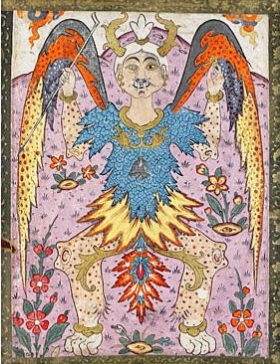 al-Dabbah, "the Beast," of Islamic eschatology. He's actually better looking
than the Dajjal, and not quite as evil--but close. (From a late-16th c. Persian miniature.)
Observations: 1.
Arab Shi`i Mahdism had been largely bottled up in Iraq by Saddam Hussein (brutally, no doubt); the US invasion and toppling
of the secular dictator has, among many other unintended consequences, let the Mahdist jinn out of the Ba`athist bottle. 2.
Western fears of a Cairo-Tehran Pan-Islamic axis are greatly exaggerated. Those who espouse such are ignorant of the
current Egyptian anxiety about that country reverting to its Fatimid past, when a (Sevener) Shi`i minority regime lorded it
over the Sunni majority. Both the Muslim Brotherhood [MB] and al-Azhar (Egypt's, and indeed the entire Sunni world's,
pre-eminent religious institution) share this disquiet about Shi`ism (and, thus, Iran). 3. But while Egypt is leery of Shi`ism and, presumably, its attendant
(and integral) Mahdism, al-Masri's screed is clear evidence that Salafi Sunnism has room for strong eschatological belief.
And recall that the Salafis are the junior partners of the MB in the ruling al-Nur party there-so any MB politicians who don't
already adhere to Sunni Mahdism as a core doctrine are likely to be exposed to it by their coalition partners.
4. Note
that these examples of strong Mahdist belief are manifesting not in the heterodox, Sufi-infused "peripheries" of
Islamic civilization--Senegal, say, or Indonesia--but rather in the very central regions of the old Muslim empires: Iraq,
Egypt and, a bit later chronologically (thanks to the Byzantines), Turkey. This demonstrates, once again, that analysts
and historians who scoff at Mahdism as a mainly marginal belief system are deluding themselves (and others).
|
|
|
|
| Jamkaran Mosque near Qom, Iran (during my trip there Aug. 2008) |
|
|
|
